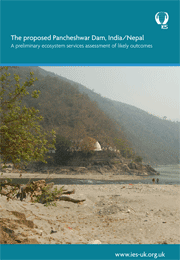The Sangam, or meeting of rivers, at Pancheshwar in the Himalayas (Uttarakhand State, India), is the site of proposals to build the Pancheshwar Dam to control flow of the Kali River and its tributaries. The proposed Pancheshwar Dam would be the world’s second-tallest, a rock-filled structure intended to harness hydroelectric power and water.
The Pancheshwar site and the substantial area affected, both upstream and down, is of significant ecological, cultural and spiritual, and well as tourism importance. Much of this would be lost were the dam to proceed. Large dams are also highly disruptive to river ecosystems for substantial distances downstream, and to the many people dependent upon them both directly and indirectly. Although there are various planned beneficial dam outcomes in terms of water and energy, it appears that these wider ramifications and their consequences for the many people potentially affected by them have not been included in planning. There is certainly a lack of engagement of local people, a paucity of published information, and consideration of environmental and social consequences have come only belatedly in the planning process, seemingly too late to influence scheme design and decisions with their associated sunk costs and for which no other options appear to have been contemplated or appraised.
On the basis of information from published sources, interviews on a site visit, and polling experts both from India and the international community, this study explores the likely marginal impacts of dam construction on the many beneficial ecosystem services provided by the river system. It was not possible to quantify or monetise these positive and negative impacts, owing largely to lack of any budget for the detailed investigations necessary to derive them. However, weighting ‘likelihood of impact’ on the basis of stated assumptions and evidence proved informative, and adequate to derive some firm conclusions. Marginal changes were assessed at two different scales: (1) local to the dam; and (2) wider catchment impacts. This highlighted potential impacts on a wide range of beneficiaries of ecosystems services, many of whom seem to have been omitted from consideration (as has so often been the case for major dam schemes around the world).
The findings from the ecosystem services analysis were structured against the seven ‘strategic priorities’ identified by the UN’s World Commission on Dams (WCD), published to guide more sustainable and equitable water resource development. The Pancheshwar proposals and process, insofar as information is available, fail all seven WCD ‘strategic priorities’ and can therefore not be assumed to be sustainable, fair or economically sound.
We conclude that the negative environmental consequences of the proposed Pancheshwar Dam would be substantial and long-lasting, and would affect people and ecosystems over a wide geographical scale. They would threaten not only high-priority nature conservation areas and the general river ecosystem downstream, but also the livelihoods of many people, both local and across the catchment, by degrading the ecosystem services provided by the catchment ecosystem. There would also be destruction of sacred sites, traditions and lifestyles, particularly amongst rural communities which have been largely omitted from consideration but potentially also affecting the wellbeing of millions of people overall. The impacts of earthquakes on dam integrity also seem to have been overlooked, despite the likely implications of the massive weight of the proposed reservoir on a highly active earthquake zone. When the quanta of substantial and overlooked costs is considered, as they seem not to have been to date in dam planning, it is highly probable that they will substantially outweigh planned benefits. It is not clear who will pick up these costs.
The net value of the proposed Pancheshwar Dam to Nepal, India and beyond is highly questionable; some potential positive outcomes appear to have been overstated whilst negative consequences have been substantially overlooked. Evidence of marginalisation of stakeholders in the decision-making process, ‘lock in’ to a single large-scale engineering solution and late development of EIAs and other studies based only on this option points to a ‘top down’ process advantageous to politically- and economically-powerful players. There is therefore a serious democratic failing in the process, with widespread potential impacts upon many people and the ecosystem services upon which they depend almost wholly overlooked.
Since only one ‘big technology’ solution is considered, and there is a lack of consideration of how people actually use water and energy and how else this might be more appropriately delivered without such major disruption to the catchment ecosystem, far-sighted decisions addressing all likely dam impacts are a remote possibility.
The evident failure to observe UN-backed ‘strategic priorities’ about dam design, the opaque decision-making process, evident favouring of already-advantaged stakeholders, failure to communicate and engage many sectors of society and a narrow focus on technology solutions exposes the Indian government, at both state and national levels, to charges or perceptions of being undemocratic and subject to nepotism, patronage and corruption. This has ramifications for the perception of India on the world stage in terms of overlooking the interests of the majority of its people, infringing their human rights and ability to participate in decisions affecting their futures, and ignoring international conventions and protocols. This may dent the confidence and fail criteria required by financial institutions including funding agencies, donors and banks, on the basis of inadequate risk assessment and additional ethical and environmental concerns.
In the light of searching questions about net public value likely to result from the Pancheshwar Dam development a currently proposed, it is recommended that the scheme is reassessed with a fresh appraisal of options on the basis of desired objectives which must this time include implications of development proposals for ecosystem services and their many beneficiaries at all scales. The WCD ‘strategic priorities’ provide an appropriate and internationally-accepted framework for this review, and it is also recommended that ecosystem services assessment is undertaken as a comprehensive and inclusive means to explore the wider environmental and societal consequences of all options to address the objectives. Transparency in the process, engagement of wide stakeholder communities, and clarity about how development proposals will contribute to public wellbeing are essential.


